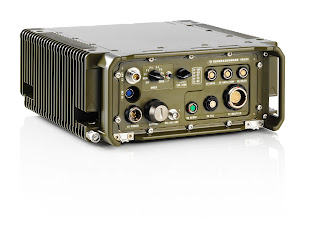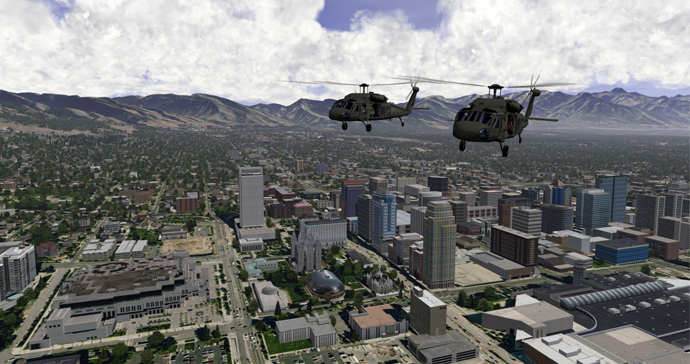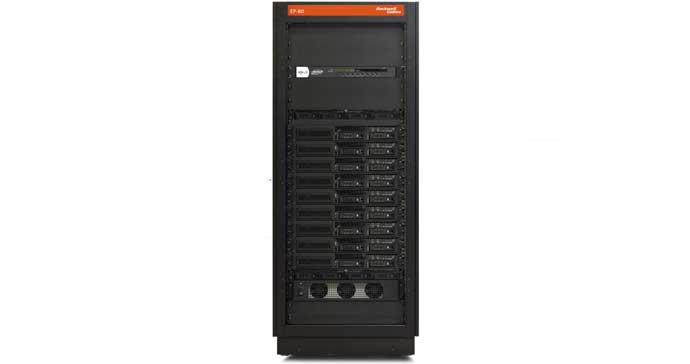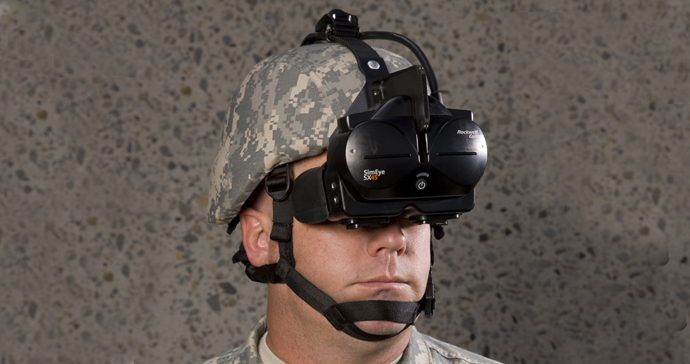Rohde & Schwarz (R&S), in a press conference, has today unveiled their brand-new R&S Software Defined Tactical Radio (SDTR), enabling high data rate, jam-resistant communications in network centric operations.
The R&S SDTR is an open platform based on the software communications architecture (SCA) standard. SCA based waveforms and other manufacturers' waveforms can be ported to the radio, paving the way for interoperability with allied Armed Forces. The R&S SDTR is an investment for the future. It has the capability to handle future international standardised waveforms with data rates of up to several Mbit/s.
Christian Leicher President & COO R&S in the first presentation explained that; "this last business year (2012) has been a record breaking year with approx. €1.88 billion (FY 11/12, July through June) revenue. The main driver has been the wireless comms industry, and and there is a tremendous amount of money invested in future technology. 16% of the annual revenue is invested in R&D, with international teams of developers close to customers anticipating technological trends."
"We are expanding our R&D network on a global scale, with the main force still in Germany, adding the US, Singapore, and key markets like China and Korea," he said. "We are confident we have a world-leading product here."
"We grew this family over the last few years," said Herbert Rewitzer, Head of the Radiocommunications Systems Division at R&S. "We developed the R&S SDTR as an open, flexible platform so that our customers can adapt their communications systems to their tasks and not the other way around – a key factor in the success of missions."
"We have an open platform and it allows waveforms by third parties," he explained.
Dr. Michael Frank, Director of Subdivision Radiocommunications Equipment R&S explained that the SDTR is interoperable in different crypto modes with NATO- future NATO-, and other coalition waveforms, as well as has the capabilities to host waveforms from allies.
R&S has developed a family of network capable, high data rate waveforms to handle diverse mission requirements. The R&S HDR waveforms transmit data and up to two voice channels in parallel, at high speed and with different priorities. Users can select the waveform that best matches their requirements on range, data rate and jamming immunity. The R&S HDR waveform family enables mobile, IP based tactical radiocommunications, the prerequisite for future networked operations. In vehicle based missions, the contactability of network nodes and the availability of bandwidths can change rapidly. The R&S HDR waveforms offer MANET capability, supporting the automatic reconfiguring of radio networks.
"There is no way for third party waveforms, running on the same SDTR, to interfere with the waveform running on the platform," Dr. Frank explained. "The SDTR is able to interact with the R&S SDAR (Software Defined Airborne Radio) and the R&S SDSR (Stationary and Shipborne Radio), where the waveform will run as well, thereby supporting joint operations."
"It is very important to send secure network information from the soldier to HQ and back," explained Dirk Lageveen Head of Sales Army Communications Systems R&S about the reason why R&S fielded this ground-breaking product.
Waveforms available are High Date Rate Wideband- (R&S HDR-WB), High Date Rate Anti-Jam Wideband- (R&S HDR-AJ-WB), and High Data Rate Anti-Jam Narrowband Waveform (R&S HDR-AJ-NB), all with a transparent interface, mobile ad hoc networking.
THe R&S HDR-AJ-WB includes a multi-slot capability (for voice and data, in all echelons).
The sophisticated security architecture of the R&S SDTR provides users with secure, reliable communications. Plain and encrypted data is strictly separated. Very fast frequency hopping rates ensure maximum immunity to jamming. These measures, combined with high-security encryption, provide optimum protection against jamming, reconnaissance and eavesdropping. This is done via the R&S software, making this a TRUE Software Defined Radio. "To protect communities of interest, security includes COMSEC, TRANSEC, and embedded and software defined Crypto, in a ruggedised crypto device with a true random number generator, tamper protection and crypto ignition key," said Dr. Frank. "We are the company to have given the market a TRUE Software Defined Radio."
The new R&S SDTR and R&S HDR waveform family are available now, and the SDAR in 2015, with the R&S SDSR shortly after, even though the SDTR could be used on ships as well, according to Dr. Frank. To a dismounted version, Herbert Rewitzer explained that R&S "will offer a complete portfolio for the Army with a mixture of OEM and their own products."
(All Photos & Graphics: R&S except where noted)
The R&S SDTR is the first in a new generation of software defined radios, together with a family of network capable waveforms. This tactical radio for vehicular and semi-mobile platforms delivers 50W of output power without external amplifiers and covers the 30-512MHz range. It meets the military's special requirements on shock resistance, size, weight and ventilation without the need for extra mechanical shock absorbers. Thanks to integrated high-performance filters, antennas can be spaced as close as one meter apart and the radio lines will not interfere with each other. The R&S SDTR, with the R&S HDR waveforms, is fully IP capable and can be easily and seamlessly integrated into existing IP networks.
The R&S SDTR is an open platform based on the software communications architecture (SCA) standard. SCA based waveforms and other manufacturers' waveforms can be ported to the radio, paving the way for interoperability with allied Armed Forces. The R&S SDTR is an investment for the future. It has the capability to handle future international standardised waveforms with data rates of up to several Mbit/s.
(Photo: DPM)
Christian Leicher President & COO R&S in the first presentation explained that; "this last business year (2012) has been a record breaking year with approx. €1.88 billion (FY 11/12, July through June) revenue. The main driver has been the wireless comms industry, and and there is a tremendous amount of money invested in future technology. 16% of the annual revenue is invested in R&D, with international teams of developers close to customers anticipating technological trends."
"We are expanding our R&D network on a global scale, with the main force still in Germany, adding the US, Singapore, and key markets like China and Korea," he said. "We are confident we have a world-leading product here."
"We grew this family over the last few years," said Herbert Rewitzer, Head of the Radiocommunications Systems Division at R&S. "We developed the R&S SDTR as an open, flexible platform so that our customers can adapt their communications systems to their tasks and not the other way around – a key factor in the success of missions."
"We have an open platform and it allows waveforms by third parties," he explained.
R&S has developed a family of network capable, high data rate waveforms to handle diverse mission requirements. The R&S HDR waveforms transmit data and up to two voice channels in parallel, at high speed and with different priorities. Users can select the waveform that best matches their requirements on range, data rate and jamming immunity. The R&S HDR waveform family enables mobile, IP based tactical radiocommunications, the prerequisite for future networked operations. In vehicle based missions, the contactability of network nodes and the availability of bandwidths can change rapidly. The R&S HDR waveforms offer MANET capability, supporting the automatic reconfiguring of radio networks.
(Photo: DPM)
"There is no way for third party waveforms, running on the same SDTR, to interfere with the waveform running on the platform," Dr. Frank explained. "The SDTR is able to interact with the R&S SDAR (Software Defined Airborne Radio) and the R&S SDSR (Stationary and Shipborne Radio), where the waveform will run as well, thereby supporting joint operations."
"It is very important to send secure network information from the soldier to HQ and back," explained Dirk Lageveen Head of Sales Army Communications Systems R&S about the reason why R&S fielded this ground-breaking product.
Waveforms available are High Date Rate Wideband- (R&S HDR-WB), High Date Rate Anti-Jam Wideband- (R&S HDR-AJ-WB), and High Data Rate Anti-Jam Narrowband Waveform (R&S HDR-AJ-NB), all with a transparent interface, mobile ad hoc networking.
THe R&S HDR-AJ-WB includes a multi-slot capability (for voice and data, in all echelons).
The sophisticated security architecture of the R&S SDTR provides users with secure, reliable communications. Plain and encrypted data is strictly separated. Very fast frequency hopping rates ensure maximum immunity to jamming. These measures, combined with high-security encryption, provide optimum protection against jamming, reconnaissance and eavesdropping. This is done via the R&S software, making this a TRUE Software Defined Radio. "To protect communities of interest, security includes COMSEC, TRANSEC, and embedded and software defined Crypto, in a ruggedised crypto device with a true random number generator, tamper protection and crypto ignition key," said Dr. Frank. "We are the company to have given the market a TRUE Software Defined Radio."
The new R&S SDTR and R&S HDR waveform family are available now, and the SDAR in 2015, with the R&S SDSR shortly after, even though the SDTR could be used on ships as well, according to Dr. Frank. To a dismounted version, Herbert Rewitzer explained that R&S "will offer a complete portfolio for the Army with a mixture of OEM and their own products."
(All Photos & Graphics: R&S except where noted)






















.jpg)



